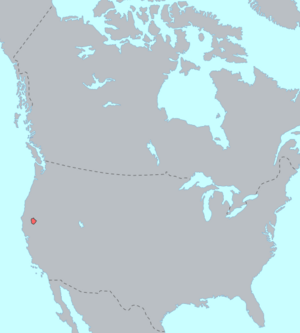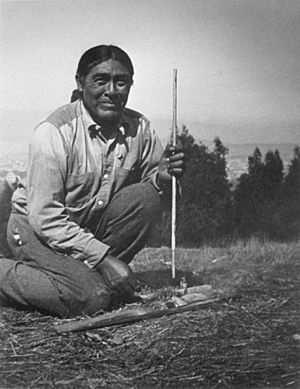Yana people facts for kids
| Regions with significant populations | |
|---|---|
| Languages | |
| Yana, English |
The Yana are a group of Native American people. They originally lived in Northern California. Their homeland was in the central Sierra Nevada mountains. This area is on the western side of the mountain range. Before white settlers arrived, their lands were near the Pit and Feather rivers.
Sadly, the Yana people faced great hardship. Many were killed during a very sad and violent time. This period was called the California Genocide. It happened in the late 1800s. Today, some Central and Southern Yana people still live in California. They are part of the Redding Rancheria community.
Who Were the Yana People?
The Yana-speaking people were made up of four main groups. These groups were the North Yana, Central Yana, Southern Yana, and the Yahi. The word Ya- means "person" in their language. The ending part of the word changed. It was -na for the northern groups. It was -hi for the southern groups.
The Yana Way of Life
Before the California Gold Rush, many Yana people lived in the area. Some experts believe there were over 3,000 Yana people. They lived by hunting wild animals and fishing for salmon. They also gathered fruits, acorns, and roots.
Their territory was very large. It covered about 2,400 square miles. This land had mountain streams, deep canyons, and rocky hills. It also had green meadows. Each Yana group had its own land. They also had slightly different ways of life and spoke different forms of the Yana language.
The Yahi Group
The Yahi were the Yana group who lived the furthest south. They were hunter-gatherers. This means they found their food by hunting and gathering plants. They lived in small groups. These groups were very equal, with no single leader. The Yahi were private people. They strongly protected their mountain canyon homeland. At first, there were about 400 Yahi people.
The Yahi were the first Yana group to be affected by the California Gold Rush. Their lands were closest to where gold was found. They lost their traditional food sources. They also fought with settlers over their land. The Yahi did not have firearms. The armed white settlers often attacked them. These attacks were part of the California Genocide. During this time, the U.S. Army and other groups killed many Native Americans. They also forced thousands of people from their homes.
In 1865, a man named Robert Anderson led two attacks. His men killed about seventy Yahi people. This made the Yahi population much smaller. They were also suffering from hunger. After these attacks, fewer than 100 Yahi were left.
More sad events happened. In August 1865, settlers attacked a Yahi village at dawn. In 1866, more Yahi were killed in a surprise attack. Around 1867, 33 Yahi were killed after being found in a cave. Finally, around 1871, about 30 Yahi were trapped and killed in Kingsley cave.
The Story of Ishi
The last known survivor of the Yahi was named Ishi. American experts gave him this name. Ishi had lived most of his life hidden in the Sierra wilderness. He lived with his mother and other family members. He came out of hiding when he was about 49 years old. By then, his mother and last relatives had passed away. He was the only Yahi person known to Americans. Ishi appeared near Oroville, California, on August 29, 1911. He had lived his whole life outside of American culture.
Professors from the University of California, Berkeley, heard about Ishi. They brought him to San Francisco. They wanted to study his culture and protect him. People called him the "last wild Indian." Many people were curious about him.
Ishi lived at the Museum of Anthropology. This was thanks to anthropologist Alfred L. Kroeber. Kroeber was the museum's director. Ishi lived there until 1916. He passed away from tuberculosis, a disease that could not be cured then.
A linguist named Edward Sapir studied Ishi's language in 1911. Sapir had already studied the northern Yana languages.
By Yahi custom, a person did not tell their name to an enemy. A friend would introduce them. Then, the name could be shared. Since Ishi was the last of his people, he had no friends at first. He later made friends at the University of California. Because of his traditions, he never spoke his own name. The researchers at the University of California, Berkeley, gave him the name Ishi. This word means "man" in the Yana language. He accepted this name. He even called himself "Mr. Ishi" when he learned enough English.
Ishi worked at the Museum of Anthropology. He helped with research. He taught Saxton Pope how to make arrows and bows. Pope was a professor at the medical school and Ishi's doctor. Ishi also taught him how to hunt with them. Pope later wrote many books about these hunting methods. He is known as the "father" of modern bowhunting.
See also
 In Spanish: Yana (tribu) para niños
In Spanish: Yana (tribu) para niños



